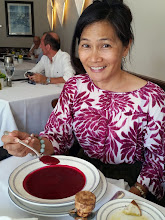For
years, I have enjoyed restriction-free eating, feeling the utmost sympathy for
those who had to omit things like shellfish, wheat, and other seemingly benign
foods from their diets. However, my doctor recently suggested that I try
avoiding soy in order to ease symptoms of hormonal change during perimenopause.
At first, I thought this would be as simple as avoiding tofu and the soy protein that I usually order with my Jamba Juice smoothies. But it proved to be much more complicated. Soy is present in things one would never suspect. I attended a conference recently, and while the hotel provided packages of gluten-free cookies for the afternoon coffee break, these goodies happened to contain soy – as did every granola bar, candy bar, and pastry in the hotel’s convenience store.
In the last decade or so, soy has been touted as good for you - in reasonable quantities. It serves as a protein source when substituted for meat, fish, or chicken. It is also believed to stave off hormonally sensitive cancers, such as breast cancer, and to aid in fighting cholesterol. However, according to a 2009 article in Scientific American, excessive consumption of genistein, the main isoflavone in soy, can disrupt reproductive and embryonic development. While the substance is thought to prevent certain reproductive cancers, too much of a good thing can be bad, particularly when ingested in mass quantities by infants or children. One cannot help but wonder if recent generations have reached puberty sooner than their parents did because of the proliferation of soy in our food.
 | |
| A Japanese meal without soy sauce is like a day without sunshine - or the sky, for that matter. |
Since soy is largely considered a good thing, it is not usually highlighted on labels as an allergen, but is buried in ingredient lists. After cleaning out the pantry, doggedly reading every package that I brought home (including some of my vitamins), and eating considerably less for about a week – somehow my doctor’s suggestion had diminished my appetite as well as my options – I lost about five pounds. This leads to the startling conclusion that we are all ingesting too much soy, most of which we don’t even know is in our food.
One of the biggest consumers of soy is the chocolate industry. Soy lecithin is what gives chocolate a creamy texture and keeps it from getting that powdery grey look, which is what happens when cocoa butter separates from the other ingredients (it's still safe to eat, FYI - just icky-looking). Soy lecithin is also used as an emulsifier in salad dressings, spreads, and other foods that mix oil and water. I’ve even been surprised to find it in oyster crackers and other commercial baked goods, sausages, prepared frozen meals, and Coffee Mate.
 |
| Van Gogh knew a good thing when he saw it - sunflower lecithin is my new best friend. To be found in better chocolates near you, including Perugina's Limoncello Bar and Guittard's baking chips. |
A real challenge is eating at Asian restaurants, where I quickly realized that there is no substitute for soy sauce. Eating buckwheat soba noodles or sushi without this vital condiment is almost pointless. However in many cases, wait staff and chefs have made a real effort to find an acceptable condiment. Valiant efforts have been made in the kitchens to accommodate my dietary quandry, ranging from a fizzy and bitter vinegar as a dip for tempura (it just wasn't right) to a wonderful sesame and red pepper sauce (props to Sushi Sumo in Gardena!) that made my sashimi better than if I were able to douse it in shoyu. With that in mind, Western cuisine is not without its hazards to the soy-sensitive. “Vegetable” or “canola” oil can sometimes contain soybean oil as well, so fish and chips might even be a bit dicey depending on where you go.
I’m continuing to eat soy-free, hoping that another month on my new program will reverse some of my symptoms. I am seeing a bit of progress, and the side effect of losing weight is also a happy by-product. A member of my writing group, who also has to steer clear of soy, as well as other allergens, compared dealing with a food allergy to stages of grief. Indeed, there is shock - food used to be my unconditionally loving friend, nourishing not only my body but often my sense of adventure. There is a level of coping, which I am still going through, for the time being. And then there is resignation and mourning.
However, becoming even more conscious of what I eat is definitely a good thing as I hurtle toward my 50th birthday. Having to ferret out an undesirable ingredient in my food has made me more aware of the unnecessary calories that I consume and of the importance of all of us knowing exactly what is in our food.
As a child of the mid- 20th Century, I was raised to believe that bounty and convenience were the hallmarks of the American diet. With all that we have learned about nutrition in the last 50 years, children are fed very differently than my peers and I were. Soda machines have disappeared from many schools, restaurants offer more meat-free options, and calories and fat are now included on menus. We are all charged with being responsible eaters. Let's just hope that the manufacturers of food become more responsible for their products as well.
For further reading:
Effects
of Genistein - Scientific American
Soybean Oil vs. Canola Oil - HowStuffCompares.com
Hormonal effects of soy in premenopausal
women and men -
US National Library of Medicine National Institutes of Health
US National Library of Medicine National Institutes of Health





